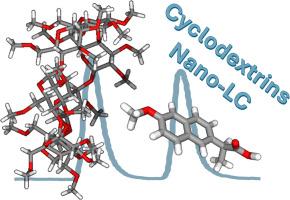利用三甲基化-β-环糊精和亚2 μm二氧化硅颗粒对映体进行纳米液相色谱分离
IF 3.2
引用次数: 0
摘要
采用自制的纳米液相色谱(nano-LC)系统,在常规压力条件下对非甾体类抗炎药(卡洛芬、环洛芬、非诺洛芬、氟比洛芬、布洛芬、吲哚洛芬、酮洛芬、萘普生和苏洛芬)的外消旋酸性化合物进行了对体分离。通过在流动相中加入七烷基(2,3,6-三- o -甲基)-β-环糊精(TM-β-CD)作为手性添加剂实现了手性分离。与3µm硅基RP18固定相的比较研究强调了固定相类型的关键作用。尽管类似或稍高的对映体分辨率因素,最显著的影响是更短的分析时间(高达一半)和更高的理论板数(估计在45,000和75,000 N/m之间),这是由固定相的颗粒尺寸减小造成的。这使得全面的有机溶剂和水含量的研究,揭示有价值的色谱见解。在大约400 nL/min的流速下,使用30 mM TM-β-CD在MeOH中,缓冲pH为3.0,获得了最有利的对映体鉴别流动相。根据绿色分析化学(GAC)的原则,并坚持白色分析化学原则,使用各种工具来评估该方法的环境影响。其中包括分析生态尺度、分析绿色度量方法和蓝色适用性等级指数,该指数评估了与绿色分析化学原则相一致的小型化分析方法。本文章由计算机程序翻译,如有差异,请以英文原文为准。

Use of tri-methylated-β-cyclodextrin and sub-2 μm silica particles for enantiomers separation by nano-liquid chromatography
A short capillary column packed with RP18 sub-2 µm particles was investigated for enantioseparation of selected racemic acidic compounds such as nonsteroidal anti-inflammatory drugs (carprofen, cicloprofen, fenoprofen, flurbiprofen, ibuprofen, indoprofen, ketoprofen, naproxen, and suprofen) using a lab-made nano-liquid chromatography (nano-LC) system at conventional pressure conditions. The chiral separations were achieved by adding to the mobile phase heptakis (2,3,6-tri-O-methyl)-β-cyclodextrin (TM-β-CD) as the chiral additive. A comparative study with a 3 µm silica-based RP18 stationary phase highlights the crucial role of the stationary phase type. Despite similar or slightly higher enantioresolution factors, the most significant effects were the shorter analysis times (up to half) and higher theoretical plate numbers (estimated between 45,000 and 75,000 N/m) resulting from the reduced particle size of the stationary phase. This enabled a comprehensive organic solvent and aqueous content study, revealing valuable chromatographic insights. At a flow rate of approximately 400 nL/min, the most favourable mobile phase for enantiodiscrimination was achieved using 30 mM TM-β-CD in MeOH with a buffer pH 3.0. In line with the principles of Green Analytical Chemistry (GAC) and adhering to the White Analytical Chemistry principles, various tools were employed to assess the environmental impact of the method. These included the Analytical Eco-Scale, the Analytical GREEnness metric approach, and the Blue Applicability Grade Index that evaluated the miniaturized analytical methodology proposed aligned with the principles of Green Analytical Chemistry.
求助全文
通过发布文献求助,成功后即可免费获取论文全文。
去求助
来源期刊

Journal of chromatography open
Analytical Chemistry
CiteScore
2.50
自引率
0.00%
发文量
0
审稿时长
50 days
 求助内容:
求助内容: 应助结果提醒方式:
应助结果提醒方式:


